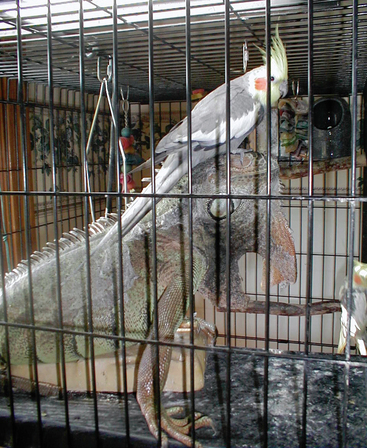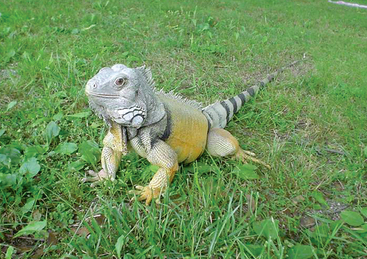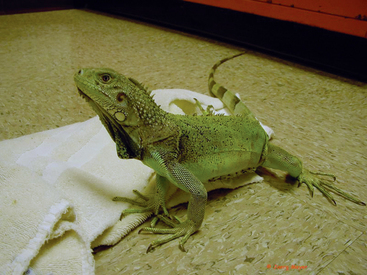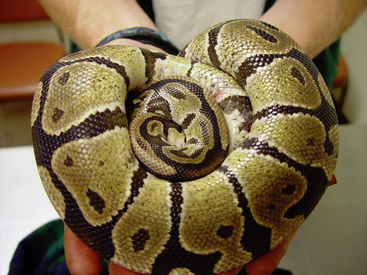CHAPTER 3 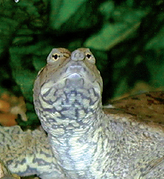 REPTILE BEHAVIOR
REPTILE BEHAVIOR
Introduction
Reptiles are becoming more and more popular as pets and as research animals. With so many reptile species being presented to the practitioner, it is difficult to stay abreast of the knowledge necessary to provide appropriate care and to counsel and educate clients. Recognition of normal and abnormal behavior could alert the caretaker and the veterinary practitioner to a medical problem at an earlier stage, making treatment more likely successful.
Although more literature about the care and handling of reptiles in captivity is being published, the amount of literature available regarding behavioral studies and observations is overwhelming. This should not be surprising, considering that the green anole (Anolis carolinensis) lizard has been the subject of behavioral and ecologic study for more than 100 years.83 Most of the existing literature in reptilian ethology, however, has been used to study reproductive behavior and the neural and muscular morphology that is involved. Also, direct comparison and conclusions drawn from behavioral observation in other species are of limited value because of the significant differences in the biology of reptiles versus other classes.29 Conclusions about the uniformity of an observed behavior pattern between reptile species also have to be made with reservations. Despite the large amount of literature available on reptile behavior, little of this knowledge is adequately reflected in the resources primarily aimed at the veterinary market.
As with other species, close cooperation and exchange of information between the owner and the clinician must be part of the examination. Without this anamnesis an adequate evaluation of the behavioral issues is impossible. A significant percentage of health problems in reptiles is related to errors in management, especially environment and diet. Despite the best intentions, it appears that many reptiles in captivity do not reach adulthood, often dying of medical complications secondary to inadequate husbandry. For example, garter snakes, which are commonly used for scientific laboratory studies or kept as pets, often become ill and die young in captivity.56 Fortunately, as our knowledge base increases and as reptile owners and clinicians become more educated, these statistics are improving.
Developmental Aspects of Behavior
To appreciate the complex discussion of behavior, we need to keep in mind the developmental nature of reptiles. The concept of ontogeny is relatively new to herpetologic research, and limited data on how behavior changes with the age of an individual reptile are available. One can roughly classify five stages of development in the life of a reptile32:
An excellent summary of the ontogeny of the green iguana (Iguana iguana) can be found in Biology, Husbandry and Medicine of the Green Iguana.4 Without doubt, the behavioral patterns of individual reptiles undergo development during the different life stages, and some of the ontogenic stages are primarily based on changes in behavior. The knowledge of these different stages and their associated behavioral patterns is especially significant in managing a reproductive colony.
The ontogeny of antipredator responses in natricine snakes has been examined. Neonates were given a standardized defensive behavior test at 1 and/or 20 days of age. Another example of ontogenic shifts in antipredator responses has been seen in an Australian scincid lizard (Eulamprus heatwolei). In this species it was noted that juveniles avoided predator odors, whereas adults showed no avoidance behaviors toward predator odors, suggesting an age-specific shift in predator avoidance behaviors. The likely cause is that the increased size serves as a deterrent to many predators.62
It has been noted in male green iguanas that femoral gland pore size and amount of secretions correlated with age and the maintenance of dominance relationships.3 Pore size was positively correlated with the frequency of headbob displays and plasma levels of testosterone during the breeding season in individuals older than 12 months of age.
Environmental Aspects of Behavior
The environmental influences in the life of a poikilotherm also play a significant role in the development of behavioral manifestations. The association of gender determination in reptiles with incubation temperature is well documented but not well understood. For example, it has been reported that incubation temperature significantly affects the hormonal environment of the embryo of a snapping turtle (Chelydra serpentina) with temperature-dependent sex determination.43 Environmental factors such as incubation humidity, oxygen, carbon dioxide concentration, and other microclimatic factors all influence the development of the young reptile.
Not only do environmental factors play a key role in the development of both embryonic and hatched reptiles, it appears that the development of basic behavioral patterns later in life is also significantly influenced by the development of the embryonic animal. For instance, during a study of antipredator behavior of hatchling snakes, results suggest that hatchlings incubated at medium temperatures are generally less vulnerable to predators than hatchlings incubated at higher or lower temperatures.17 These data suggest that the development of behavior is strongly influenced by early morphologic developmental factors.
Incubation temperature during embryonic development has been found to significantly alter of adult aggressiveness and attractiveness in leopard geckos (Eublepharis macularis); adult female geckos from a male-biased incubation temperature (32° C; 90° F) were more aggressive and the females less attractive than the geckos arising from female-biased incubation temperatures (26°, 30°, and 34° C; 79°, 86°, and 93° F).49 In addition, the authors noted that postnatal hormones played a role in the sociosexual behaviors of adult geckos as well.
A later paper also suggests that male-typical behaviors in the adult leopard gecko are permanently affected by both embryonic temperature and gonadal sex during development,30 and a still-later report suggests that developmental temperatures may primarily affect the level of circulating hormones in adulthood in geckos that are gonadally intact.108 In the red-sided garter snake (Thamnophis sirtalis parietalis), research data suggest that sex steroid hormones act to organize central nervous system mechanisms influencing courtship behavior such that temperature, and not hormonal fluctuations, activate sexual behavior in the adult.28 The truth for most behavioral patterns might be somewhere in between; observation of certain species supports the impression that environmental and internal factors act together in the development of these complex behavioral patterns.
Without a doubt the environment is crucial in the morphologic development and the survival of reptile hatchlings. It is only reasonable that these factors will have a similar and significant influence on behavior. Although the environmental temperature strongly influences the developing animal, more and more data suggest that other influences such as humidity can have significant developmental impact. A good example of continued dependence on correct environmental factors is discussed in a recently published report regarding the influence of environmental humidity on pyramidal growth of carapaces in the African spurred tortoise (Geochelone sulcata).131 The authors concluded that the major contributing factor of this abnormality is inadequate humidity.
The influence and importance of the ultraviolet (UV) spectrum on behavior has long been established. Research is being done on the UV spectrum in reptiles and how it affects behavior. The two most important fractions of the UV spectrum are the long wave (UV-A) and the midwave (UV-B) fractions. The UV-A spectrum has been suggested to influence agonistic, reproductive, and signaling behaviors in some species of lizards.55 In a study of courtship behavior in the agamid lizard (Ctenophorus ornatus) with reflectance spectrometry, which extends into the UV spectrum, it was suggested that the function of visual display in this species of lizard appears to be intersexual signaling, possibly resulting in the males’ choice of females.76
The role of the midwave fraction (UV-B) of the UV spectrum in the synthesis of active vitamin D3 will not be discussed here. However, it has been shown that panther chameleons (Chamaeleo [Furcifer] pardalis) will actively change their exposure to UV light depending on the dietary intake of vitamin D3.44 If the dietary levels of the vitamin are high, the animals limit their exposure to the UV light source, and alternately they increase the exposure if dietary levels are low (see Eating Behaviors). It has also been documented that some reptiles become more aggressive when exposed to unfiltered natural sunlight,51,91 although normal behavior is usually resumed when the reptile is returned to its enclosure.
In addition to general environmental factors influencing reptiles, data also exist that outline the impact of geographic location on morphologic and behavioral development. One of the most obvious connections between behavior and local microhabitat was documented in populations of Japanese natricine snakes (Rhabdophis tigrinus) deprived of their natural diet, which consists mainly of toads. With an artificial diet, these snakes lacked secretions of the nuchal gland that are used to deter predators. Without the secretory defense, these snakes more frequently exhibited a flight response when threatened.95
Environmental pollution has also been documented to have a profound impact on the developing reptile, and detrimental changes in behavioral patterns have been noted. High environmental concentrations of lead have been shown to affect the righting reflex of reptiles as well as having other detrimental effects.18 Aside from environmental pollution, which can be measured and assessed fairly easily, other factors of human impact on nature and consequently on reptilian behavior are more difficult to measure. However, some of these behavioral consequences have been documented. For example, the effect of artificial light sources, referred to as photo-pollution, near beaches used by sea turtles has a detrimental effect on the nest site selection and interferes with the water location capability of the hatchlings.124
Social and Antisocial Behaviors
For proper management of reptiles in captivity it is of absolute importance to know the social structure of the reptile species, because an inadequate setup will trigger stress responses in the animals and immunosuppression can follow (Box 3-1). Additional evidence that an elevated social status may provide advantages was noted in a study of response to stress in the green anole lizard (A. carolinensis). The dominant male anoles showed reduced somatic indicators of stress, including a progressive darkening from green to brown coloring and expression of a black postorbital eyespot, than subordinate males. They also recovered more quickly from the stress.102
BOX 3-1 How Behavior Relates to Captivity
Adapted from Bradley TA: Reptile behavior basics for the veterinary clinician. In Proceedings of the ARAV Annual Conference, Reno, Nev., 2002.
The signs of social stress can be very subtle and may not be clinically evident to an owner or clinician. Often an owner must be convinced that such stress exists and must be eliminated in order to keep the reptiles healthier. Social stress can be minimized when housing nongregarious reptile species together in environments by providing sufficient space and appropriate hiding spaces. It has been theorized that basking placement in reptiles in the wild can indicate hierarchic position in a group, whereby the most dominant is at the highest basking position. For example, in a study of captive juvenile male green iguanas (I. iguana), housed where supplemental heat and perch sites were limited, a divergence in growth and behavior was noted within 1 to 2 months.101 It was shown that dominant males grew more rapidly and used the supplemental heat sources twice as often as the subordinate males. Because onset of adult behavioral patterns is related to body size, the dominant males also displayed adult behaviors much sooner. Providing multiple basking areas for groups of reptiles may minimize some of this social stress.
Most reptiles are not considered to be social animals, and relatively few reptiles live constantly in social groups and establish a social hierarchy. The social tendencies of reptilian behavior vary with species and age. Although many reptiles show a significant increase in social behavior at breeding time, for the majority of the year even these species prefer a solitary lifestyle. For instance, large social aggregations of garter snakes and other snake species have been documented in preparation for the breeding season, whereas for the rest of the year they prefer a more solitary existence.
Juvenile reptiles, however, often exhibit a more social lifestyle with conspecifics than do adults. As long as the animals are not yet sexually active and sufficient food is available, juveniles will aggregate without agonistic behaviors. This is evident in juvenile green iguanas, which tend to stay on the ground and live under thick shrubbery in groups (exhibiting the safety-in-numbers theory). They often sleep with their heads pointed toward the outside of the brush to allow early detection of predators. It has been documented in different reptile species that food consumption is significantly increased when young animals are housed in groups versus individual enclosures.127
Although snakes are commonly considered to be the least social reptiles, recent data suggest that this might not be accurate. Rattlesnakes, for instance, exhibit characteristics consistent with advanced sociality, including group defense, conspecific alarm signals, and maternal defense of young. These findings reinforce the notion that rather than being solitary and asocial, some snake species may form family groups.21 Another research study revealed that Australian black rock skinks (Egernia saxatilis) exhibited long-term monogamy, stable social grouping, and evidence of “nuclear family” systems, attesting to the fact that the social organization of some reptiles may be more complex than previously suspected.97
Agonistic Behaviors
When appropriate, and with the permission of the owner, the reptile patients nails should be trimmed before examination and handling to minimize trauma to staff and the clinician. Also, many lizard species will not let go when they bite and may actually bite more assertively as the “victim” struggles. The different reptile species demonstrate a wide variety of defensive behavioral patterns, and extensive handling experience is needed in order to read the behaviors accurately.
Provoked defensive aggressive behaviors in reptiles include posturing that makes the aggressor appear to be more threatening, such as inflation of the body, standing more erect on all four legs, broadside posturing, dewlap extension, open-mouthed threat, and head bobbing (Figure 3-2). Biting, striking, and tail whipping may also be seen. Male frill-necked lizards (Chlamydosaurus kingii) will also kick and bite at one another while displaying extension of the frill around their necks. Some species of reptiles are able to produce a noxious substance to deter aggressors or predators, including the spraying of urine, feces or musk.
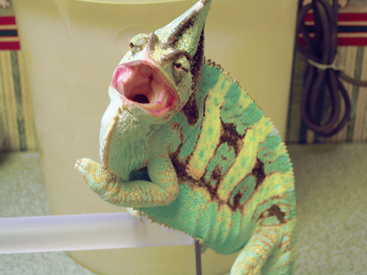
Figure 3-2 A chameleon exhibiting an open-mouth threat display in response to being handled.
(Courtesy Teresa Bradley Bays.)
Other unusual behaviors reported in reptiles include a reaction that could be mistaken for pathologic central nervous system signs. When confronted by an ophiophagous (snake-eating) kingsnake, venomous snakes of the subfamily Crotalinae exhibit a suite of defensive responses including head hiding, thrashing, and other unusual responses.59 Many of these behaviors are discussed in further detail in the sections that follow.
Territorial Defense
Defending a territory comes at a price, and the benefits must outweigh the cost. Food abundance appears to be one of the key factors in territorial defense. It has been hypothesized that the lack of home range defense in certain herbivorous and omnivorous lizards and turtles is directly related to the concentration of resources available to these species in their environment.103 Defending these resources does not outweigh the potential dangers associated with aggression. During a sudden abundance of food, defending a home range appears less important, and individuals that would defend their food source will readily share the food. For example, when feasting on a large carcass, Komodo dragons will readily share the resource peacefully,103 although they are usually considered solitary animals. Of all the reptile species studied to date, home range defensive behavior appears to be most prevalent in the iguanian and gekkotan lizards.103
However, snakes in captivity do quickly establish territorial markers in the cage, and constant rearrangement of cage furniture or cleaning the cage might add additional stress. It has also been shown that snakes use pheromones on the newspaper bedding in order to mark their territory.63 This finding might suggest that it is best to change the substrate in a serpent tank only on an as-needed basis rather than on a daily basis in order to decrease stress.
Combat for Mating
Problems with sexual aggression toward humans by reptiles have been reported most commonly with the green iguana (I. iguana)72,88 during the breeding season when hormone levels are fluctuating; such problems are often initiated by the presence of a menstruating human female. Some iguanas will revert back to their normal docile behavior after the breeding season is complete, but others remain aggressive. Certain lizard species may also become more aggressive when exposed to natural unfiltered sunlight, although normal behavior is usually resumed when the reptile is placed back in its enclosure (Figure 3-3). Any reptile that is approached too quickly or handled inappropriately may also show signs of aggression.
It has been suggested that sexually mature male iguanas that are showing signs of aggression may have some of the behaviors curtailed by decreasing daylight hours, eliminating exposure to other male animals in the house as well as to female conspecifics, and decreasing environmental temperatures slightly. The practitioner should stress to the client, however, that aggression is a normal expected behavior for iguanas, and that efforts to control behavior should not be extreme enough to cause harm to the iguana. Depo-Lupron and Depo-Provera have both been used with mixed results in an attempt to decrease human-directed aggression in male iguanas. Castration of male iguanas before sexual maturity may help to decrease the chance of reproductive-related aggression toward people and other pets.52 Clients should be counseled that castration before puberty would also decrease the development of secondary sexual characteristics including large jowls and crests.
Defensive Antipredator Behaviors
Passive Defensive Behaviors (Avoidance)
Avoiding Detection (Crypsis).
Because reptiles have generally low oxidative metabolic capacities and are incapable of outrunning most predators, they rely heavily on hiding as a form of defense.103 If the reptile senses a threat or danger and is a considerable distance away, it will try to move out of the area unnoticed in order to avoid detection and fighting. A reptile will always try to avoid detection, as this is the least energy-consuming variation of predator avoidance and allows the animal to remain in the same locale. The animal will usually try to physically hide its body in a crevice or a burrow.
Escape Behavior (Direct Evasion).
If the reptile does not sense impending danger and is surprised by the sudden appearance of a stimulus, it will try to rapidly move away from the source of potential danger. This can involve leaping out of a tree and diving into water or into rock crevices. The predator will usually notice the commotion caused by the sudden movement. This sudden and sometimes clumsy flight reaction can be observed in captivity if a lizard is asleep and is startled. This may cause the lizard to fall from a perch or basking area.
The lack of closing eyelids makes the assessment of whether or not a snake is resting more difficult than in other reptiles. However, if the pupils appear to be fixed and do not respond to mild visual clues (e.g., hand movement by the glass), a sudden stimulus can cause a flight reaction in the snake (Figure 3-4).
Caudal Autotomy (Tail Shed).
One of the more commonly known defensive strategies is the partial loss of the tail, known as caudal autotomy. Many lizards and a very few snakes are able to lose the distal aspect of the tail when grabbed by a chasing predator or by an unsuspecting owner or practitioner. Frequently the piece of tail that falls off will continue to wriggle in order to distract the predator while the reptile is escaping. The tail should therefore never be used to restrain a lizard. Typically little blood loss results from autotomy. The tail breaks at a fracture plane in the center of a vertebra. After several months a shorter cartilaginous rod will replace the bone, and the scales covering it will be irregular and discolored.
Death Display.
Another predator defense is to mimic death. One of the best known species to show this behavior is the eastern hog-nosed snake (Heterodon platirhinos). The animal turns upside down, opens its mouth, and releases a foul-smelling odor. Other species of snakes also display this behavior, and Eckstein42 reports that during handling of grass snakes (Natrix natrix) approximately one quarter of them pretended to be dead, with this behavior triggered only by touching them. This behavior was not exhibited to the same degree by all snakes. Some of them coiled up with the mouth held slightly open, often with the tongue lolling out of the side of the mouth. Other snakes turned their heads to the side with fixed pupils and mouths opened, sometimes with completely relaxed body muscles. In a more intense reaction the black and creamy colored underside would be presented, showing either the throat area or the entire ventrum. The snakes would pretend to be dead for 2 minutes to half an hour. When the grass snakes did not feel threatened any more, they darted their tongues several times and then they went to a hiding spot (Eckstein, at www.ringelnatter.net).42 This defense, however, is useful only against predators that are attracted by motion.
Active Defensive Behaviors
Self-Inflation and Vocalization.
A bioacoustic analysis was conducted on the defensive sounds produced by 21 species of snakes. The “typical” snake hiss is described as having a broad-frequency span (from roughly 3000 to 13,000 Hz) with a dominant frequency near 7500 Hz.132 Whether or not this hissing is also part of a true communication process is still not known.
Symbolic Bite and Biting.
If the source of danger is close and a snake is unable to evade using other behaviors, a “fake” strike can sometimes be observed. This symbolic bite usually happens with a closed mouth and is directed in the general direction of the aggressor and often repeated very quickly. This defense is used against larger predators and has significant intimidation potential. It will usually persist until the predator gives up or is confused, and the snake uses this moment to evade the situation by using a flight response. A variation of this defense is the typical “cobralike position.” The snake will hold up the cranial third of the body and strike in a forward and downward motion. The snake is able to move while striking and can cover significant distance during this display. Lizards and chelonians will also demonstrate their readiness to bite with an open-mouth display.
Biting is usually the final step in an escalation of behaviors, but it can also happen without warning. Usually snakes will avoid biting for defensive reasons. It has been shown that most of the injuries resulting from snake-human interaction would be avoidable if common sense were used. A study examining snake bites concluded that the majority of snakebite injuries resulted from intentional exposure to snakes in which a variety of factors such as the use of alcohol and lack of protective equipment likely played a role.94
Tail Flicking and Tail Whipping.
The rattlesnake is the best known snake that exhibits tail flicking behavior whereby a vibration of the tail of the snake creates sound. Eckstein42 reported the observation of this tail vibration in the grass snake, N. natrix, as well. In the case of the grass snake the end of the tail is hit against grass or other surfaces in order to create sound. Other reptiles, such as the green iguana (I. iguana), show a similar behavior when agitated.
Lizards often use the tail to strike out at predators, or if provoked in the examination room. A large green iguana (I. iguana) may assume a U-shaped posture with the head and tail presented when defending itself from the suspected predation of the clinician and staff. In this posture the body is protected, the tail can be used as a weapon or sacrificed (see Caudal Autotomy), and the mouth is ready to inflict injury if necessary. Practitioner and staff should be aware of this defensive behavior and be careful in handling such an animal.
Miscellaneous Defenses
Blood Spurting.
The horned lizards, Phyrnosoma species, belong to one of several species that are able to restrict blood flow from the head until the blood pressure mounts enough to create rupture of the small blood vessels in and around the eyes. This defense against certain predators results in blood spurting up to 1 meter away.103
Coiling Up.
The best-known species to use coiling as a defensive behavior is the ball python, but other snakes have also been observed to exhibit this behavior. The snake curls up and may move rapidly in this position or may remain absolutely still (Figure 3-5).
Taming and Training
Training of reptiles has been successfully done in order to facilitate clinical procedures. The advantages of such training are obvious, as the trainer can condition the animal such that clinical data can be obtained without having to physically interact with the animal. The use of classical and operant conditioning in training for venipuncture and other husbandry issues in Aldabra tortoises (Geochelone gigantea) has been described.129 Similar positive results have been reported in the training of the Nile crocodile81 and the Komodo dragon.48 The application of operant conditioning can have significant positive influence on managing a reptile collection and should be considered in species that are dangerous to handle and need to be handled on a regular basis.
Even a relatively “tame” pet reptile may become fractious when stressed. A nervous lizard tends to flatten itself laterally, widen its eyes, and in some cases extend the dewlap. Lizards may also hold their mouths agape in a threatening gesture if frightened (see Figure 3-2). As described previously, iguanas and other lizards that are placed on an examination table may assume a U-shaped position with the tail pointed toward the practitioner, ready to defend themselves if needed.
Sensory Modalities and Behavior
In order to understand behavioral responses triggered by sensory perception, a minimal understanding of the physiology of the sensory system is needed. It is beyond the scope of this chapter to address the physiologic aspects appropriately, and we recommend Biology, Husbandry, and Health Care of Reptiles, edited by Ackerman,1 for a better overview. As an extremely broad summary, it could be stated that for snakes the chemical pathway is the most important sense for communication with the environment, as snakes make very limited use of the visual system. However, the visual system appears to be the primary sense for communication with the environment for lizards and turtles.
Vomeronasal Organ, Olfaction, and Behavior
It is difficult to separate the VO from the rest of the sensory organs, as it appears to be intricately affiliated with the rest of the olfactory system. We believe that the organ deserves mention since the VO has historically been considered the most important chemosensory organ of reptiles. Research has focused extensively on this organ.133 Recent scientific evidence indicates that it can act independently and does not depend on the rest of the olfactory system. For example, it has been found that the use of chemical signals by garter snakes in shelter selection and aggregation is mediated by the VO and that neither the olfactory nor the visual system is critical for these behaviors.63 In a publication investigating the specific stimulation of the VO and the olfactory tract of garter snakes, a significant preference of the VO for nonairborne stimulants like liquids was noted, whereas the olfactory organ was triggered by all volatile test substances.68
Data regarding olfaction and reproductive behavior are available for the garter snake (T. sirtalis) indicating that pheromones play a major role in reproductive behavior. Male snakes have been reported to court random objects, if they were laced with female pheromone scents.85 Also, male turtles of certain species show a variety of courtship behaviors, which are thought to be triggered by pheromone-producing glands of the female turtles.
Squamate reptiles locate conspecifics by scent trailing, and prey is identified and located by tongue flicking; they can apparently locate food using only airborne cues.24 Chemosensory reception is also important for predator detection and allows the nocturnal, rock-dwelling velvet gecko (Oedura lesueurii) to detect the scent of the broad-headed snake (Hoplocephalus bungaroides). As an ambush predator the broad-headed snake benefits by remaining sedentary in rock crevices awaiting the foraging geckos, thereby minimizing the extent of scent distribution on the surrounding rocks.40
Another major aspect of how smell affects behavior is related to feeding habits. Predatory reptiles have been shown to use olfaction as a means to find their prey. This was demonstrated in a Y-maze apparatus in which garter snakes were trained to follow an earthworm-extract trail. Correct trailing improved significantly as training progressed using the extract of the prey animal.75 Foraging behavior of turtles has also been linked to the olfactory system, as a disruption of the olfactory organ impaired the foraging ability in affected turtles.133
Odor presentation studies concluded that hatchling iguanas may recognize one another by differences in body odor produced from the femoral glands.2 Through use of nasal chemosensory systems, lizards have been found to be able to make sophisticated pheromonal discriminations about the reproductive condition of potential mates and sexual rivals as well as the presence of other species.25
Stay updated, free articles. Join our Telegram channel

Full access? Get Clinical Tree


